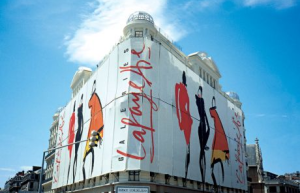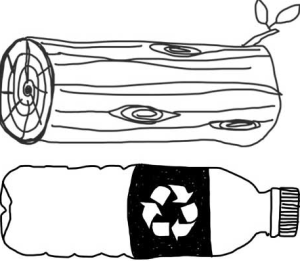Many industries employ the use of printed polyester fabric in apparel, home furnishings, and in advertising, known as fabric graphics. The textile industry, as it relates to apparel recycling, is active. At present, it appears to be less in vogue to discover who recycles large format fabric graphics. The print media for fabric graphics are typically woven polyester knits. Polyester or PET (polyethylene terephthalate), is made from naturally occurring plant chemistry and synthetics derived from the petroleum industry.
My business produces fabric graphics for advertising agencies, corporations, retailers, museums and universities. We print fabric graphics with a printing process called dye sublimation transfer. The dyes are water-based inks which get sealed into the fibers when passed through high temperature compression rollers. Polyester works optimally for this process because the fibers open fully at the melting point, allowing the inks to become encapsulated into the fibers when cooled. Neither water nor dirt can offend this product because it can be washed and reused. It does not require a protective coating, such as lamination or glass. Those protective coatings usually introduce glare issues, especially when viewing at great distances and various angles. Large format fabric graphics are quite large and meant to be viewed from across the room. As with any industry, there is waste due to quality control and the process of trimming out the fabric. The challenge is to find qualified recycling for my industry as well as those who take down the graphics once the ad campaign or season is completed. Just what is to become of these grand scale graphics? There has got to be a better solution than filling up our landfills!
Turning to the internet to discover a perfect solution is not as fruitful as one might expect. Sure there are recycling markets out there, but the market is soft. Recycling means you break it down to its former parts. It comes down to money, and with the price of fuel being low, so is the market for recycling polyester fabric as it relates to the petroleum market.
I did discover that two scientists over in Australia, from the Deakin Institute for Frontier Materials, came up with a way to sort out the poly-cotton blends. They use an ionic liquid (salt in a liquid state) to recover the polyester portion and recycle them into new thread or plastic products. I’m not aware of this anyone implementing this process here in the US.
Seeking alternative solutions, I discovered it is possible to up-cycle or re-purpose post-consumables. The distinction between recycling and re-purposing is as follows: the purpose of recycling is to break down post-consumer waste into their basic form. Up-cycling is the process of converting old or discarded materials into something new that’s useful and perhaps, beautiful. Re-purposing or up up-cycling does not require you to break down the materials into its basic parts, but rather re-fashion the old with a new purpose. For now, I’ve contacted the local SPCA to see if they might appreciate our material waste for stuffing the pets beds. I have expanded my search to those in the re-purposing business in the US.
What about you? Have you discovered a good source for recycling the waste from your business? Please contact me to continue this discussion: info@photoworksgroup.com
Recent Posts
Archives
- September 2016
- March 2016
- December 2015
- November 2015
- October 2015
- August 2015
- July 2015
- June 2015
- May 2015
- April 2015
- January 2015
- November 2014
- October 2014
- August 2014
- July 2014
- June 2014
- May 2014
- April 2014
- March 2014
- February 2014
- January 2014
- December 2013
- November 2013
- October 2013
- September 2013
- August 2013
- July 2013
- June 2013
- April 2013
- November 2012
- October 2012
- September 2012
- August 2012
- July 2012
- June 2012
- May 2012
- April 2012
- March 2012
- February 2012
- January 2012
- December 2011
- November 2011
- October 2011
- September 2011
- August 2011
- July 2011
Categories
- & mounting
- ADA signage
- airport graphics
- Backlit Fabric Graphics
- backlit graphic
- backlit graphics
- blog
- Contour cuts
- digital imaging
- Dye Sub
- Dye Sublimation Graphics
- Fabric Graphics
- fabrication for architects
- finishing
- Finishing services
- Framing
- Giclee
- Large format graphics
- Latex prints
- Lightjet prints
- Lightjet Prints
- Museum Exhibits
- Outdoor banners
- Prints on metal
- Sports Facility Exhibits
- Trade Show Displays
- Uncategorized
- UV Direct Prints



Recent Comments